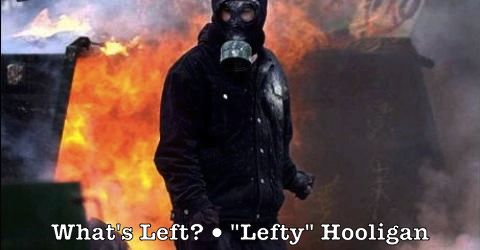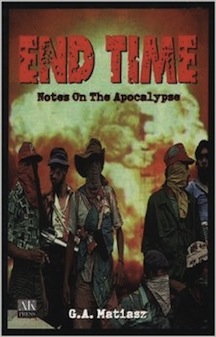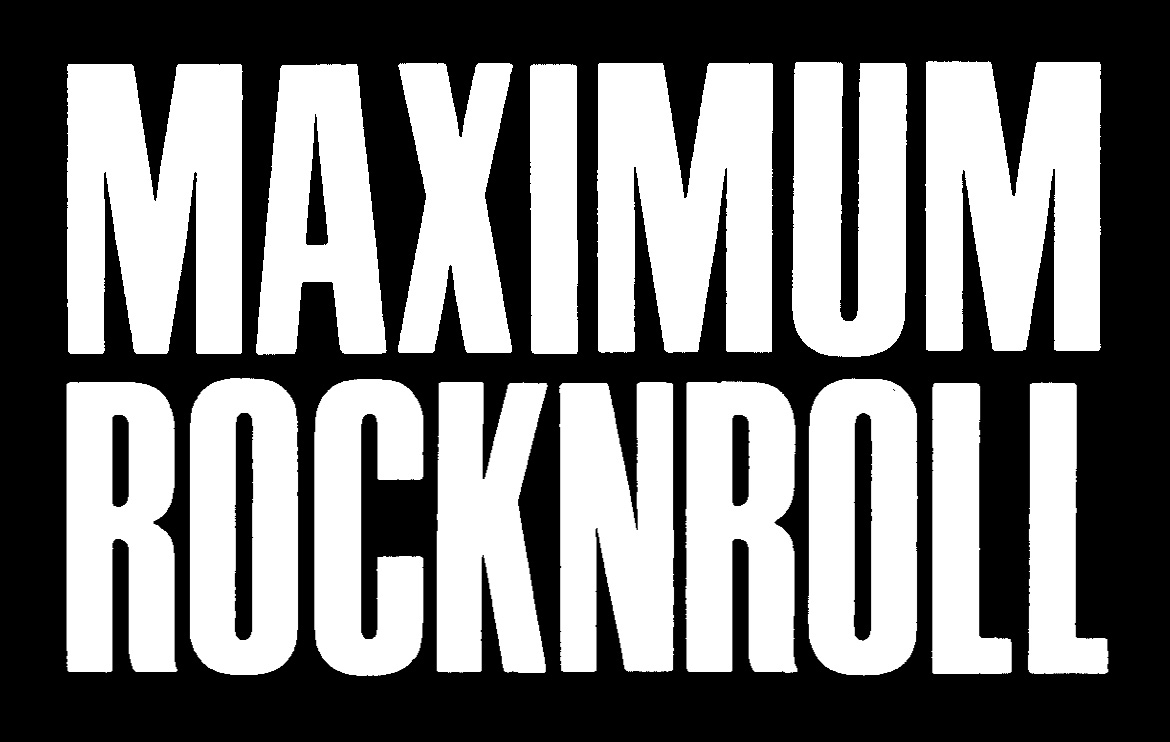
This is my overlong analysis of the crisis of the Left and the crisis on the Right . I owe the tripartite analysis of the modern American Right to Political Research Associates, which does excellent work dissecting the Right through investigative reports, articles, and activist resource kits.
———
Things fall apart; the centre cannot hold/Mere anarchy is loosed upon the world
W.B. Yeats, “The Second Coming”
Yet periods of ideological decay often breed strange new variants, such as the ‘Red-Brown alliance’ in the former Soviet Union, which do not easily fit into conventional political-science categories of “left” and “right.”
Kevin Coogan, Dreamer of the Day
I’m ass deep into analyzing the crisis of the Left. There are three components to this crisis, beginning with the defeat of organized labor by ascendant neoliberalism in the industrialized west (Reagan busting the PATCO unions in 1981, Thatcher defeating striking coal miners in 1984-85). Next came the collapse of real existing socialist regimes with the disintegration of the Soviet bloc in 1989-91. These two events mark the decline of Marxism broadly and Leninism more narrowly as the third component of this ongoing crisis. The present growth of anarchism and left communism and the breeding of “strange new variants” like insurrectionism and communization I consider a mixed blessing because this actually demonstrates the Left’s weakness. The relationship between the resurgence of the anti-authoritarian Left and the decline of the rest of the Left, in turn, reflects a broader relationship between the politics of Left and Right, with the “ideological decay” of the Right hinting at something broader.
If the crisis of the Left is also a crisis on the Right, perhaps I need to use the word interregnum. The sentiment of the Yeats poem, borne by the mystic, cryptofascist Irish nationalist in his reactionary politics, conveys the sense of a violent interruption between old and new orders. An old order loses its grip, but before a new order manages to establish itself there is a period of social chaos and disintegration when things “do not easily fit into conventional political-science categories of ‘left’ and ‘right’.” An interregnum, by definition, is a big deal.
The Latin term interregnum originated with the English civil war to designate the period from the execution of Charles I in 1649 to the Restoration of Charles II in 1660. Cromwell’s dictatorship is sometimes considered a prequel to the bourgeois revolutions that ushered in the modern world. Most of the history I tend to fixate on—the French 1789 Revolution, the Russian 1917 Revolution, the German 1918-19 workers’ revolt ushering in the Weimar Republic, the Spanish 1936-39 civil war, etc.—also indicate relatively short-lived, national interregnums. But interregnums can also be long and slow moving, involving a much wider geographic scope.
The Papal Schism that split the western church between three contending popes from 1378 to 1417 damaged the Catholic church’s reputation and authority. Along with issues of priestly celibacy, the marketing of relics, and most importantly the selling of indulgences, the Protestant Reformation was all but inevitable. From Martin Luther’s posting of his 95 Theses in 1517 through the Peace of Westphalia in 1648, Europe experienced scores of religious wars predicated on dynastic conflicts and as many as 20 million deaths due to religious violence, not to mention a continental reshaping of European social, political, and economic realities that eventually gave rise to the modern nation-state system. That’s over a century-long, diffuse, continental interregnum. Alternately, the series of national interregnums from the beginning of the first World War in 1914 to the end of the second World War in 1945 might be threaded together into a single, grand, worldwide interregnum. A global interregnum
I’m paleo when it comes to my Marxism. Interregnums fit nicely into a history propelled by class struggle and revolution. As for modes of production and stages of history, I’m both less and more orthodox. Less because I don’t think historical modes of production prior to capitalism were comprehensive, and more because once the capitalist mode of production arose it eventually became socially and globally all-embracing. And I’m definitely old school in contending that the French revolutionary interregnum of 1789 ushered in the modern world, starting with the riotous sans culotte and culminating in Napoleon’s more disciplined conscripts sweeping across continental Europe.
The first bourgeois revolution in France coincided with a wide variety of interrelated historical processes and cultural phenomena—from the Enlightenment and scientific revolution to modern warfare and the rise of industrial capitalism—to mark the watershed between pre-modern and modern eras. It also introduced our modern-day distinctions between Left and Right through the representative seating at the 1789 National Assembly. Here’s a standard high school PolySci description: “In a narrow sense, the political spectrum summarizes different attitudes towards the economy and the role of the state: left-wing views support intervention and collectivism; and right-wing ones favor the market and individualism. However, this distinction supposedly reflects deeper, if imperfectly defined, ideological or value differences. Ideas such as freedom, equality, fraternity, rights, progress, reform and internationalism are generally seen to have a left-wing character, while notions such as authority, hierarchy, order, duty, tradition, reaction and nationalism are generally seen as having a right-wing character.” [Andrew Heywood, Key Concepts in Politics and International Relations] The Left’s stress on reason and program in accepting modernity makes for greater structure and coherence compared to the eclectic, muddy stance of the non-rational, instinctual Right in the rejection of modernity. But it all does come down to an embrace of, versus a revolt against, the modern world.
And here we encounter a contradiction central to the Right. For in order to revolt against the modern world, the Right must simultaneously embrace it. Moderate conservatives like Edmund Burke who were terrified by the French Revolution were dragged kicking and screaming into modernity, accepting the economics of Adam Smith and the private property of Locke while demanding that tradition put the breaks on changes wrought by capitalism. Reactionaries like Joseph de Maistre advocated for “throne and altar” in a restored ancien regime—a Counter Enlightenment counterrevolutionary—yet he still admired Napoleon. The Left went full-bore into mass politics, vanguard parties, technological innovation, and heavy industrialization with the Bolshevik turn after 1917, yet another national interregnum. From Mussolini’s 1922 March on Rome through Hitler’s 1933 acceptance of the German chancellorship, the extreme Fascist right responded by producing an anti-liberal, anti-conservative, anti-capitalist, anti-Marxist revolutionary mass politics to reindustrialize central Europe around a vanguardist, ultranationalist, palingenetic core. The Right has always been in reaction to the Left because of this central contradiction, and there are scholars of Fascist Studies who claim that Fascism was actually a synthesis of revolutionary Left and Right.
Lacking a feudal past, a universal church, and monarchist and aristocratic traditions, the Right in the United States remained confined to moderate conservative factions in the prominent pre-civil war electoral parties—Federalists, Democratic-Republicans, Whigs, and Jacksonian Democrats. It’s been argued that the American Right actually started as a form of European liberalism. At its most immoderate, early American conservatism demonstrated strong nativist and isolationist tendencies, as with the American “Know Nothing” Party. The country’s Protestant citizenry was subject to populist Great Awakenings, rightwing fundamentalist movements, and heretical cults like Mormonism. And, of course, the prevailing assumption across the board was that the United States was a white man’s nation, owned and run by white people. Southern slave society came closest to offering a European-style Right based on aristocracy and tradition. The struggle over slavery that lead to the civil war also drove conservative elements of the southern Democratic Party into the extremism of the Ku Klux Klan’s white supremacist militia terrorism after the civil war, while much of the GOP drifted into an isolationist, laissez-faire Old Right.
Along with a revival in rightwing religious movements like Christian evangelicalism and pentecostalism, the United States witnessed its own fascist movement paralleling European Fascism between the world wars. Based on a reborn, white supremacist, mass KKK that was also anti-Catholic, antisemitic, and populist, it included the antisemitic ravings of Father Coughlin, Charles Lindbergh’s America First movement and sympathies for Nazi Germany, Pelley’s Silver Shirts and Christian Party, even the more demagogic leftist populism of Huey Long. The threat of an American Fascism was very real in the 1920s and 30s.
With the defeat of Nazi Germany and Fascist Italy at the end of the global interregnum, in large part thanks to the Soviet Red Army, it was assumed that Fascism had been liquidated once and for all. The United States assumed for itself the sole superpower and the center of empire, capable of imposing a Pax Americana over the world, except for an obstreperous Soviet Union. Some form of Cold War anti-communism became a mainstay of mainstream American politics. It should be remembered that Joseph McCarthy started out a Democrat and ended up a Republican. McCarthyism, the John Birch Society, and Barry Goldwater’s faction of the Republican Party were all radically anti-communist.
But the Right in the United States remained fractious. It included the antisemitic white supremacism of the Klan, George Wallace and the Dixiecrat revolt, the beginnings of the patriot/militia movement in DePugh’s Minutemen and Beach’s Posse Comitatus, the paleoconservatism of Russell Kirk and Paul Gottfried, embryonic conspiracy theorizing a la Bircher anti-fluoridation paranoia, Ayn Rand’s atheist Objectivism, the first inklings of Murray Rothbard’s AnCap libertarianism, and the like. In contrast to the rightwing alliance between Christian evangelicals and Catholic bishops on everything from school prayer to abortion, serious theological divisions emerged in Reconstructionism, Dominionism, and Christian Nationalism alongside religious cults like Children of God, Unification Church, Fundamentalist LDS, Church Universal and Triumphant, etc. As the Right so often mirrors the Left, American conservatism tried to force a contrapuntal unity against the perceived “international communist conspiracy for world domination.”
William F. Buckley founded the National Review Magazine in 1955 in an explicit effort to demarcate a proper American conservatism and to keep it properly policed through vicious polemics and purges of racists, antisemites, and conspiracy wingnuts. He wanted an official American conservative movement that overlapped with the Republican Party, a pro-business/anti-union conservative movement dedicated to a disciplined, uncompromising, good-vs-evil crusade against communism. Buckley thought of this as standing athwart history, yelling stop, in his version of revolting against modernity, but he discovered that policing the Right was like herding cats. It’s been argued that Buckley’s National Review conservative movement was a facade; that the Right didn’t grow less diverse or more unified under Buckley’s shepherding. Yet what ultimately vanquished Buckley and the conservative movement was the crisis of the Left that bubbled up during the 1980s, culminating in the Soviet bloc’s sudden collapse from 1989 to 1991. The United States won the Cold War and truly became the sole superpower and center of empire. Yet things fell apart and the center could not hold as another global interregnum took shape.
I argue that the crisis of the Left produced a corresponding crisis on the Right, a proliferation of “strange new variants” on the Right. The Reagan/Thatcher neoliberal rebranding of official conservatism primed the crisis, alongside the direct mail Viguerie New Right and imported rightwing countercultural currents like Skinheads. All sectors of the Right subsequently proliferated, from the Secular Right (Libertarianism, Neoconservatism) through the Religious Right (soft and hard Dominionism) to the Xenophobic Right. The latter witnessed the most explosive growth through populist movements (armed citizen militias, Sovereign Citizens, patriot groups) and white nationalist ultraright movements (Christian Identity, Creativity Movement, National Socialist Movement, National Alliance).
The most visible aspects of the growing Right—the Tea Party Movement and now the Alt.Right—are just the tip of the rightwing iceberg. Whereas the Secular Right remains committed to a pluralist civil society, the Xenophobic Right is hardline anti-democratic, with the dividing line between conservative and hard Right falling somewhere in the Religious Right. The confusing variety on the Right can barely be contained by this conceptual triad, unlike the Left’s greater structure and coherence which falls easily into antiauthoritarian, democratic/parliamentary, and Leninist categories.
The changes to global capitalism that underpinned the rise of this current global interregnum must wait until a future column. I’ll conclude by quoting Tom Robinson: “If Left is Right, then Right is Wrong. You better decide which side you’re on.”
August 1, 2017
Categories: 1950s, 1960s, 1968, 1970s, anarchism, Barry Goldwater, bourgeoisie, capitalism, Christianity, communism, conservatism, Democratic Party, fascism, France 1968, Germany 1918, GOP, Great Depression, Hitler, Karl Marx, left communism, Leninism, libertarianism, Marxism, Marxism-Leninism, Modernism, nationalism, Nazi Germany, Neoliberalism, Politics, Populist movement, Republican Party, Russia 1917, Russian Revolution, Soviet Union, Spain 1936-39, Tea Party, ultraleftism, William F. Buckley . Tags: 1789 National Assembly, 1922 March on Rome, 1933 German chancellorship, Adam Smith, alt.right, American “Know Nothing” Party, American First movement, anarchism, anarchist capitalism, anti-authoritarian Left, anti-communism, armed citizen militias, Ayn Rand, Barry Goldwater, Beach’s Posse Comitatus, Charles Lindbergh, Children of God, Christian Identity, Christian Nationalism, Church Universal and Triumphant, class struggle, coal miners, communization, Counter Enlightenment, Creativity Movement, Cromwell, democratic Left, Democratic-Republicans, DePugh’s Minutemen, Dixiecrats, Dominionism, Edmund Burke, English civil war, fascism, Father Coughlin, Federalists, first World War, French 1789 Revolution, Fundamentalist LDS, George Wallace, German 1918-19 workers’ revolution, Glorious Revolution, GOP, Great Awakenings, Hitler, Huey Long, insurrectionism, interregnums, Jacksonian Democrats, John Birch Society, John Locke, Joseph de Maistre, Joseph McCarthy, Kevin Coogan, Ku Klux Klan, laissez-faire Old Right, Left, left communism, Leninist Left, libertarianism, Margaret Thatcher, Martin Luther, Marxism, Marxism-Leninism, McCarthyism, militia movement, modern world, modernity, modes of production, Mormonism, Murray Rothbard, Mussolini, Napoleon, National Alliance, National Review Magazine, National Socialist Movement, Nazism, Neoconservatism, Objectivism, paleoconservatism, Papal Schism, parliamentary Left, PATCO, patriot groups, patriot movement, Paul Gottfried, Peace of Westphalia in 1648, Pelley’s Silver Shirts and Christian Party, populist movements, Protestant Reformation, Reconstructionism, Red Scare, Religious Right, Republican Party, revolt against modern world, revolt against modernity, Richard Nixon, Right, Ronald Reagan, Russell Kirk, Russian 1917 revolution, sans culotte, second World War, Secular Right, skinheads, social democratic Left, social revolution, soft and hard Dominionism, Sovereign Citizens, Soviet bloc, Soviet Union, Spanish 1936-39 civil war, stages of history, Tea Party, Tom Robinson, Unification Church, Viguerie New Right, W.B. Yeats, Weimar Republic, Whigs, William F. Buckley, Xenophobic Right . Author: leftyhooligan . Comments: Leave a comment
 I picked up an archaic paper flyer pinned to an obsolete cork board in the now-defunct Market Street branch of FLAX Art Supplies. The handbill advertised a web designer and mobile app developer—Daniel Goodwyn—who offered to teach virtually any platform or software. I wanted to learn social media to prepare for self-publishing my novel 1% Free, so I called. He was cheap. We arranged to meet at Philz Coffee on 24th Street.
I picked up an archaic paper flyer pinned to an obsolete cork board in the now-defunct Market Street branch of FLAX Art Supplies. The handbill advertised a web designer and mobile app developer—Daniel Goodwyn—who offered to teach virtually any platform or software. I wanted to learn social media to prepare for self-publishing my novel 1% Free, so I called. He was cheap. We arranged to meet at Philz Coffee on 24th Street.








